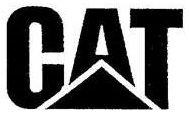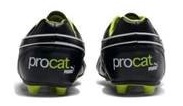Caterpillar have successfully appealed a decision by the Registrar to dismiss their opposition to registration of Puma's procat mark (as shown below) for goods in Classes 18 and 25.

O'Bryan J held that, having regard to fair and normal use of the procat mark outside Australia, Puma's mark was deceptively similar to Caterpillar's earlier registrations for both CAT (word) and associated CAT logo mark (as shown below) for goods in Classes 18 and 25. Further, his Honour was also satisfied that due to the extent of Caterpillar's reputation in Australia for the CAT and CAT Logo marks for goods in Classes 18 and 25, Puma's use of the procat mark for such goods in Australia would be likely to cause confusion.
Background
In October 2016, Puma sought to register the mark procat in Australia for goods in Classes 18 and 25 including clothing, footwear, bags and other accessories. Caterpillar subsequently opposed registration of this mark under ss42(b), 44 and 60 before the Registrar, but failed to establish any of the opposition grounds.
With respect to the s44 ground, Caterpillar argued the procat mark was too similar to a number of earlier registrations for both CAT and CAT Logo that are registered for goods in Classes 18 and 25. However, the Registrar's delegate concluded that due to the visual, phonetic and conceptual differences between these marks, Puma's procat mark was not deceptively similar to either the CAT or CAT Logo mark.

With respect to the s60 ground, Caterpillar argued that due to the extent of their use and reputation in both the CAT and CAT Logo marks, Puma's use of the procat mark for the claimed goods was likely to deceive or cause confusion. While Puma conceded that Caterpillar's CAT Logo mark had acquired a reputation in Australia at the priority date, the Registrar agreed with Puma's submission that Caterpillar's use of the CAT word mark was minimal and insufficient to establish that it had acquired the requisite reputation at the priority date.
Further, the Registrar agreed with Puma's submission that the reputation acquired by the CAT Logo mark would serve to reduce the likelihood of deception or confusion. On this basis, the Registrar was not satisfied that because of the reputation acquired by the CAT logo, Puma's use of the procat mark would be likely to deceive or cause confusion.
With respect to the s42(b) ground, Caterpillar argued that due to the extent of its reputation, Puma's use of the procat mark would be contrary to the Australian Consumer Law. However, given the Registrar's conclusions under the s60 ground above, Caterpillar also failed to establish this ground of opposition.
Federal Court Appeal
Caterpillar appealed the Registrar's decision to the Federal Court of Australia, seeking to rely on the same three grounds of opposition. As such an appeal involves a de novo hearing, Caterpillar were able to provide additional evidence in support of these opposition grounds.
Section 44
Caterpillar again sought to rely on the use and registration of its earlier registrations for both CAT and CAT Logo for goods in Classes 18 and 25. In response, Puma again submitted there are sufficient visual, phonetic and conceptual differences between procat and Caterpillar's CAT and CAT Logo marks, such that these marks should not be regarded as deceptively similar.
While Puma are yet to commence using the procat mark in Australia, Caterpillar submitted evidence as to how Puma have used the procat mark in the United States and Canada. Caterpillar submitted that such evidence was relevant to illustrate what would be fair and normal use of the mark by Puma, which is relevant to the assessment of deceptive similarity. Caterpillar's evidence showed that Puma used the procat mark in lower case with the letters "pro" and "cat" being rendered in different shades or colours as illustrated below. Further, Puma's online marketing of the relevant footwear referred to the brand as "ProCat" (using the upper case "P" and "C").

O'Bryan J accepted Caterpillar's submission that such use falls within the parameters of fair and normal use of the mark. His Honour also took the view that Puma's use of the procat mark in Australia (in the same manner as used in the USA and Canada), would constitute a use with alterations which do not substantially affect the identity of the trade mark.
O'Bryan J concluded that the fact Puma applied to register the procat mark as a fancy mark (in lower case with sans-serif font) does not limit the trade mark rights granted upon registration to use with a single colour or shade of lettering or indeed to use without any letters being capitalised.
His Honour did not place any material weight on the fact that Puma's evidence suggested that it was common for at least some traders to use multiple trade marks or branding elements on and in connection with footwear. The evidence on this issue was not conclusive and, in any event, in assuming normal and fair use of the mark applied for, the use or possible use of other marks is ignored.
On this basis, his Honour concluded that Puma's procat mark was deceptively similar to Caterpillar's CAT and CAT Logo marks on the combined effect of the following:
- the word "cat" comprises the whole of the CAT word mark and one of the two elements of the CAT device mark. The word "cat" constitutes half the letters of the PROCAT mark and one of its two syllables;
- an ordinary consumer is likely to read, comprehend and pronounce the PROCAT mark as a combination of two words, "pro" and "cat";
- the relevant trade context concerns a wide range of apparel, footwear, bags and accessories sold in retail stores and online in the workwear and lifestyle market segments. The evidence showed, and it is a matter of common experience, that goods of the type under consideration are common everyday purchases that are modestly priced and sold through overlapping trade channels.
As such, O'Bryan J concluded that "there is a real and tangible risk that a significant number of consumers, who were familiar with but had an imperfect recollection of the CAT mark, would be confused as to whether goods labelled with the PROCAT mark were connected in the course of trade with CAT branded goods, as being a "professional" or high performance or otherwise special line of CAT goods. There is a real and not remote risk that the use of the word "pro" in conjunction with the word "cat" in the PROCAT mark, when used on apparel, footwear, bags and accessories, would convey to many consumers that goods branded with the PROCAT mark are professional or high performance goods which are made or endorsed by, or otherwise associated with, Caterpillar. As such, consumers would be caused to wonder whether there is commercial connection between PROCAT branded goods and Caterpillar".
Section 60
Caterpillar also sought to establish that, due to the extent of its reputation in the CAT and CAT Logo marks in Australia for goods such as clothing, footwear, bags and other accessories, Puma's use of the procat mark for such goods was likely to cause confusion. In this regard, Caterpillar filed a number of affidavits by various brand managers, licencees and distributors who were responsible for the manufacture and distribution of goods bearing the CAT and CAT Logo marks.
Based on their lengthy use of the CAT and CAT Logo marks in Australia, O'Bryan J was satisfied that Caterpillar had a substantial and valuable reputation in Australia in each of the CAT marks in relation to apparel, footwear, bags and accessories. While his Honour accepted that Caterpillar's evidence shows far more frequent use of the CAT Logo mark (compared to the CAT word mark), he did not consider there to be any material difference in the extent of reputation associated with the CAT word and CAT Logo marks.
In contrast to the Registrar, his Honour did not accept Puma's submission that the CAT marks had such a strong reputation in Australia (and Australian consumers had such familiarity with the CAT marks), that confusion with the PROCAT mark would be unlikely. While the evidence showed the CAT marks had a strong reputation in Australia at the priority date in respect of apparel, footwear, bags and accessories, his Honour took the view that the CAT marks could not be described as famous or very famous (in contrast to the findings made in respect of the brand "Maltesers", the subject of the decisions in Mars1 and Delfi2).
On this basis, O'Bryan J concluded that "there is a real and tangible risk that a significant number of consumers, who were familiar with the reputation of the CAT marks but had an imperfect recollection of those marks, would be confused as to whether goods labelled with the procat mark were connected in the course of trade with CAT branded goods, as being a "professional" or high performance or otherwise special line of CAT goods".
Section 42(b)
Caterpillar also sought to oppose registration under s42(b), namely that Puma's use of the procat mark would contravene ss18 and 29(1)(g) and (h) of the Australian Consumer Law. As Caterpillar sought to rely on the same evidence and contentions advanced under the s60 (reputation) ground, O'Bryan held that Caterpillar's reliance on s42(b) was superfluous. In this regard, his Honour remarked that reliance on s42(b) (by reference to the Australian Consumer law) only has utility where the Appellant seeks to rely on additional evidence and contentions that are not relevant to the s60 analysis. In the absence of such additional evidence or contentions, O'Bryan decided that it was unnecessary to consider this ground of opposition further.
Puma have now filed an appeal in relation to this matter.
Footnotes
1 Mars Australia Pty Ltd v Sweet Rewards Pty Ltd [2009] FCA 606; 81 IPR 354
2 Delfi Chocolate Manufacturing SA v Mars Australia Pty Ltd [2015] FCA 1065; 115 IPR 82
The content of this article is intended to provide a general guide to the subject matter. Specialist advice should be sought about your specific circumstances.
